check engine YAMAHA XVS650 2001 Owners Manual
[x] Cancel search | Manufacturer: YAMAHA, Model Year: 2001, Model line: XVS650, Model: YAMAHA XVS650 2001Pages: 106, PDF Size: 16.06 MB
Page 19 of 106
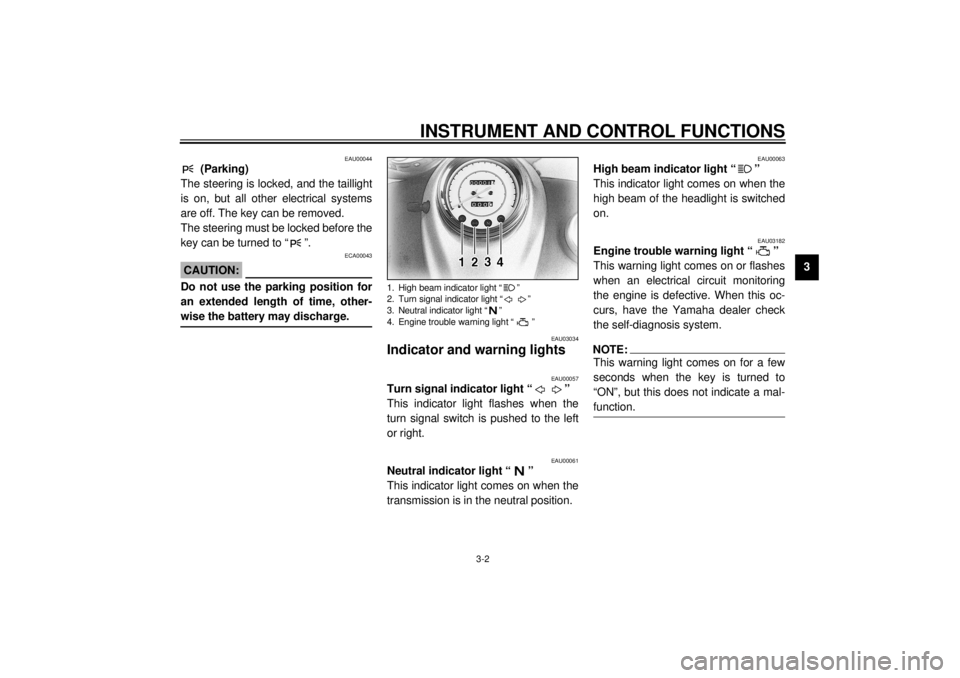
INSTRUMENT AND CONTROL FUNCTIONS
3-2
3
EAU00044
(Parking)
The steering is locked, and the taillight
is on, but all other electrical systems
are off. The key can be removed.
The steering must be locked before the
key can be turned to “ ”.
ECA00043
CAUTION:@ Do not use the parking position for
an extended length of time, other-
wise the battery may discharge. @
EAU03034
Indicator and warning lights
EAU00057
Turn signal indicator light “ ”
This indicator light flashes when the
turn signal switch is pushed to the left
or right.
EAU00061
Neutral indicator light “ ”
This indicator light comes on when the
transmission is in the neutral position.
EAU00063
High beam indicator light “ ”
This indicator light comes on when the
high beam of the headlight is switched
on.
EAU03182
Engine trouble warning light “ ”
This warning light comes on or flashes
when an electrical circuit monitoring
the engine is defective. When this oc-
curs, have the Yamaha dealer check
the self-diagnosis system.NOTE:@ This warning light comes on for a few
seconds when the key is turned to
“ON”, but this does not indicate a mal-
function. @
1. High beam indicator light “ ”
2. Turn signal indicator light “ ”
3. Neutral indicator light “ ”
4. Engine trouble warning light “ ”
E_5bn.book Page 2 Wednesday, October 4, 2000 7:51 PM
Page 33 of 106

INSTRUMENT AND CONTROL FUNCTIONS
3-16
3
EW000044
WARNING
@ The motorcycle must not be ridden
with the sidestand down, or if the
sidestand cannot be properly
moved up (or does not stay up), oth-
erwise the sidestand could contact
the ground and distract the opera-
tor, resulting in a possible loss of
control. Yamaha’s ignition circuit
cut-off system has been designed to
assist the operator in fulfilling the
responsibility of raising the side-
stand before starting off. Therefore,
check this system regularly as de-
scribed below and have a Yamaha
dealer repair it if it does not function
properly. @
EAU03720
Ignition circuit cut-off system The ignition circuit cut-off system (com-
prising the sidestand switch, clutch
switch and neutral switch) has the fol-
lowing functions.l
It prevents starting when the trans-
mission is in gear and the side-
stand is up, but the clutch lever is
not pulled.
l
It prevents starting when the trans-
mission is in gear and the clutch
lever is pulled, but the sidestand is
still down.
l
It cuts the running engine when
the transmission is in gear and the
sidestand is moved down.
Periodically check the operation of the
ignition circuit cut-off system according
to the following procedure.
EW000045
WARNING
_ If a malfunction is noted, have a
Yamaha dealer check the system
before riding. _
E_5bn.book Page 16 Wednesday, October 4, 2000 7:51 PM
Page 34 of 106
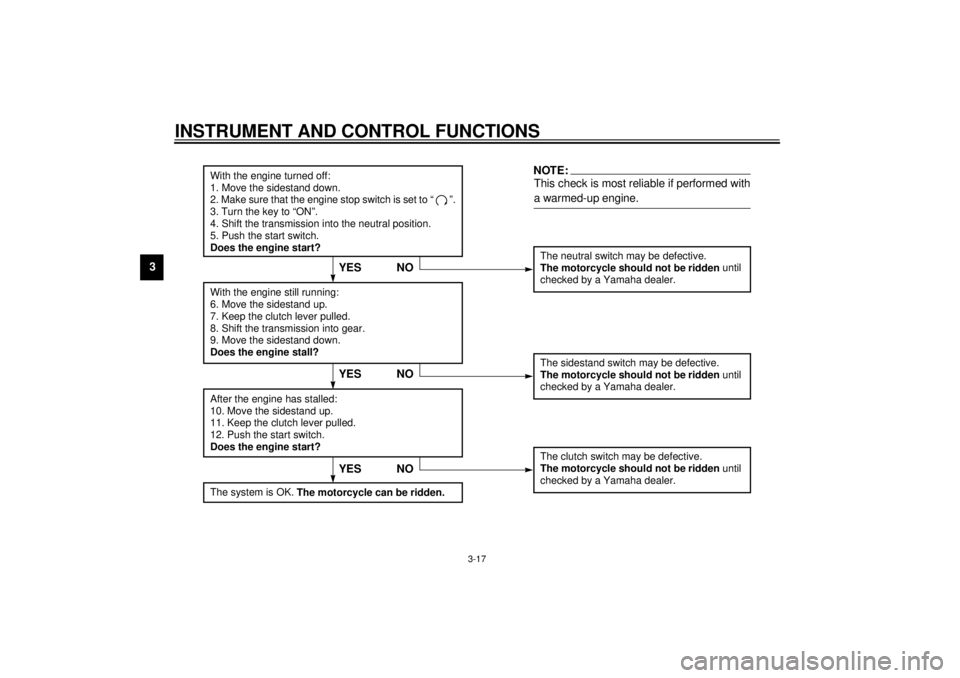
INSTRUMENT AND CONTROL FUNCTIONS
3-17
3
CD-01E
With the engine turned off:
1. Move the sidestand down.
2. Make sure that the engine stop switch is set to “ ”.
3. Turn the key to “ON”.
4. Shift the transmission into the neutral position.
5. Push the start switch.
Does the engine start?
The neutral switch may be defective.
The motorcycle should not be ridden until
checked by a Yamaha dealer.
With the engine still running:
6. Move the sidestand up.
7. Keep the clutch lever pulled.
8. Shift the transmission into gear.
9. Move the sidestand down.
Does the engine stall?After the engine has stalled:
10. Move the sidestand up.
11. Keep the clutch lever pulled.
12. Push the start switch.
Does the engine start?
The sidestand switch may be defective.
The motorcycle should not be ridden until
checked by a Yamaha dealer.The clutch switch may be defective.
The motorcycle should not be ridden until
checked by a Yamaha dealer.
NO
NOTE:This check is most reliable if performed with
a warmed-up engine.
YESYES NO
The system is OK.
The motorcycle can be ridden.
YES NO
E_5bn.book Page 17 Wednesday, October 4, 2000 7:51 PM
Page 36 of 106

4-1
4
EAU01114
4-PRE-OPERATION CHECKSThe condition of a vehicle is the owner’s responsibility. Vital components can start to deteriorate quickly and unexpectedly,
even if the vehicle remains unused (for example, as a result of exposure to the elements). Any damage, fluid leakage or loss
of tire air pressure could have serious consequences. Therefore, it is very important, in addition to a thorough visual inspec-
tion, to check the following points before each ride.
EAU03439
Pre-operation check list
ITEM CHECKS PAGE
Fuel• Check fuel level in fuel tank.
• Refuel if necessary.
• Check fuel line for leakage.3-7–3-8
Engine oil• Check oil level in engine.
• If necessary, add recommended oil to specified level.
• Check vehicle for oil leakage.6-9–6-11
Final gear oil• Check vehicle for oil leakage. 6-11–6-12
Front brake• Check operation.
• If soft or spongy, have Yamaha dealer bleed hydraulic system.
• Check lever free play.
• Adjust if necessary.
• Check fluid level in reservoir.
• If necessary, add recommended brake fluid to specified level.
• Check hydraulic system for leakage.6-20–6-21, 6-23–6-25
Rear brake• Check operation.
• Check pedal free play.
• Adjust if necessary.6-21–6-25
Clutch• Check operation.
• Lubricate cable if necessary.
• Check lever free play.
• Adjust if necessary.6-19–6-20
Throttle grip• Make sure that operation is smooth.
• Lubricate throttle grip, housing and cables if necessary.
• Check free play.
• If necessary, have Yamaha dealer make adjustment.6-15, 6-25
E_5bn.book Page 1 Wednesday, October 4, 2000 7:51 PM
Page 40 of 106
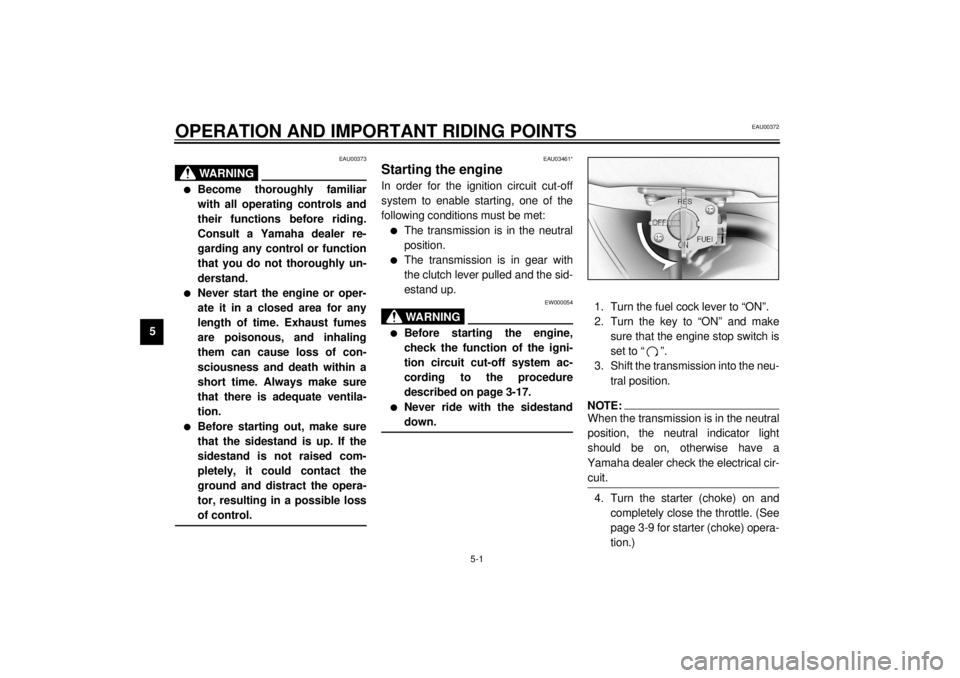
5-1
5
EAU00372
5-OPERATION AND IMPORTANT RIDING POINTS
EAU00373
WARNING
@ l
Become thoroughly familiar
with all operating controls and
their functions before riding.
Consult a Yamaha dealer re-
garding any control or function
that you do not thoroughly un-
derstand.
l
Never start the engine or oper-
ate it in a closed area for any
length of time. Exhaust fumes
are poisonous, and inhaling
them can cause loss of con-
sciousness and death within a
short time. Always make sure
that there is adequate ventila-
tion.
l
Before starting out, make sure
that the sidestand is up. If the
sidestand is not raised com-
pletely, it could contact the
ground and distract the opera-
tor, resulting in a possible loss
of control.
@
EAU03461*
Starting the engine In order for the ignition circuit cut-off
system to enable starting, one of the
following conditions must be met:l
The transmission is in the neutral
position.
l
The transmission is in gear with
the clutch lever pulled and the sid-
estand up.
EW000054
WARNING
@ l
Before starting the engine,
check the function of the igni-
tion circuit cut-off system ac-
cording to the procedure
described on page 3-17.
l
Never ride with the sidestand
down.
@
1. Turn the fuel cock lever to “ON”.
2. Turn the key to “ON” and make
sure that the engine stop switch is
set to “ ”.
3. Shift the transmission into the neu-
tral position.NOTE:@ When the transmission is in the neutral
position, the neutral indicator light
should be on, otherwise have a
Yamaha dealer check the electrical cir-
cuit. @4. Turn the starter (choke) on and
completely close the throttle. (See
page 3-9 for starter (choke) opera-
tion.)
E_5bn.book Page 1 Wednesday, October 4, 2000 7:51 PM
Page 41 of 106
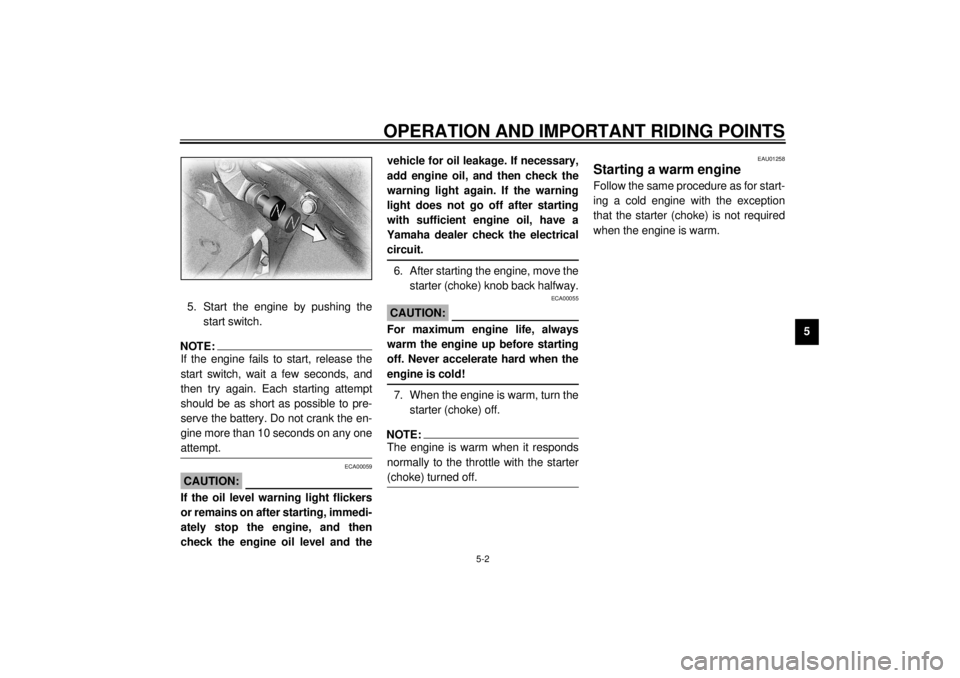
OPERATION AND IMPORTANT RIDING POINTS
5-2
5 5. Start the engine by pushing the
start switch.
NOTE:@ If the engine fails to start, release the
start switch, wait a few seconds, and
then try again. Each starting attempt
should be as short as possible to pre-
serve the battery. Do not crank the en-
gine more than 10 seconds on any one
attempt. @
ECA00059
CAUTION:@ If the oil level warning light flickers
or remains on after starting, immedi-
ately stop the engine, and then
check the engine oil level and thevehicle for oil leakage. If necessary,
add engine oil, and then check the
warning light again. If the warning
light does not go off after starting
with sufficient engine oil, have a
Yamaha dealer check the electrical
circuit.
@6. After starting the engine, move the
starter (choke) knob back halfway.
ECA00055
CAUTION:@ For maximum engine life, always
warm the engine up before starting
off. Never accelerate hard when the
engine is cold! @7. When the engine is warm, turn the
starter (choke) off.NOTE:@ The engine is warm when it responds
normally to the throttle with the starter
(choke) turned off. @
EAU01258
Starting a warm engine Follow the same procedure as for start-
ing a cold engine with the exception
that the starter (choke) is not required
when the engine is warm.
E_5bn.book Page 2 Wednesday, October 4, 2000 7:51 PM
Page 43 of 106
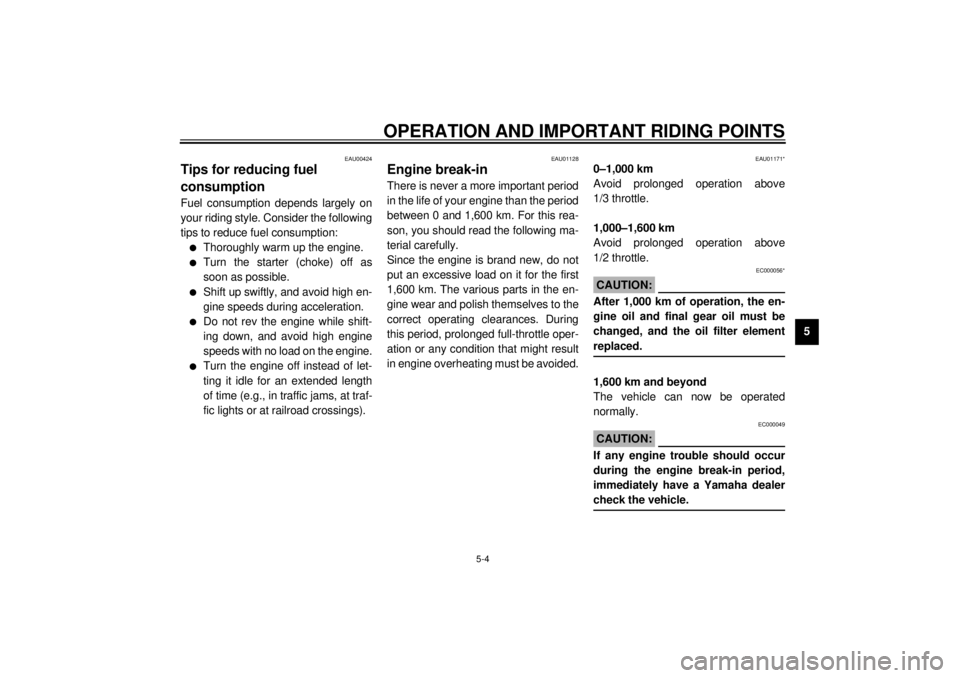
OPERATION AND IMPORTANT RIDING POINTS
5-4
5
EAU00424
Tips for reducing fuel
consumption Fuel consumption depends largely on
your riding style. Consider the following
tips to reduce fuel consumption:l
Thoroughly warm up the engine.
l
Turn the starter (choke) off as
soon as possible.
l
Shift up swiftly, and avoid high en-
gine speeds during acceleration.
l
Do not rev the engine while shift-
ing down, and avoid high engine
speeds with no load on the engine.
l
Turn the engine off instead of let-
ting it idle for an extended length
of time (e.g., in traffic jams, at traf-
fic lights or at railroad crossings).
EAU01128
Engine break-in There is never a more important period
in the life of your engine than the period
between 0 and 1,600 km. For this rea-
son, you should read the following ma-
terial carefully.
Since the engine is brand new, do not
put an excessive load on it for the first
1,600 km. The various parts in the en-
gine wear and polish themselves to the
correct operating clearances. During
this period, prolonged full-throttle oper-
ation or any condition that might result
in engine overheating must be avoided.
EAU01171*
0–1,000 km
Avoid prolonged operation above
1/3 throttle.
1,000–1,600 km
Avoid prolonged operation above
1/2 throttle.
EC000056*
CAUTION:@ After 1,000 km of operation, the en-
gine oil and final gear oil must be
changed, and the oil filter element
replaced. @1,600 km and beyond
The vehicle can now be operated
normally.
EC000049
CAUTION:@ If any engine trouble should occur
during the engine break-in period,
immediately have a Yamaha dealer
check the vehicle. @
E_5bn.book Page 4 Wednesday, October 4, 2000 7:51 PM
Page 45 of 106
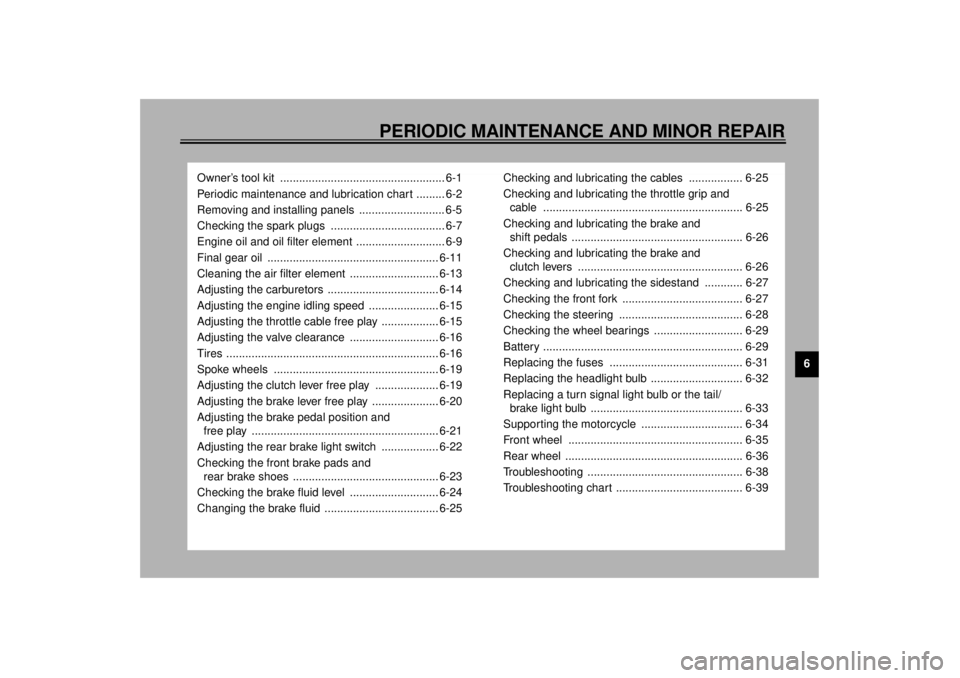
6
PERIODIC MAINTENANCE AND MINOR REPAIR
Owner’s tool kit .................................................... 6-1
Periodic maintenance and lubrication chart ......... 6-2
Removing and installing panels ........................... 6-5
Checking the spark plugs .................................... 6-7
Engine oil and oil filter element ............................ 6-9
Final gear oil ...................................................... 6-11
Cleaning the air filter element ............................ 6-13
Adjusting the carburetors ................................... 6-14
Adjusting the engine idling speed ...................... 6-15
Adjusting the throttle cable free play .................. 6-15
Adjusting the valve clearance ............................ 6-16
Tires ................................................................... 6-16
Spoke wheels .................................................... 6-19
Adjusting the clutch lever free play .................... 6-19
Adjusting the brake lever free play ..................... 6-20
Adjusting the brake pedal position and
free play ........................................................... 6-21
Adjusting the rear brake light switch .................. 6-22
Checking the front brake pads and
rear brake shoes .............................................. 6-23
Checking the brake fluid level ............................ 6-24
Changing the brake fluid .................................... 6-25Checking and lubricating the cables ................. 6-25
Checking and lubricating the throttle grip and
cable ............................................................... 6-25
Checking and lubricating the brake and
shift pedals ...................................................... 6-26
Checking and lubricating the brake and
clutch levers .................................................... 6-26
Checking and lubricating the sidestand ............ 6-27
Checking the front fork ...................................... 6-27
Checking the steering ....................................... 6-28
Checking the wheel bearings ............................ 6-29
Battery ............................................................... 6-29
Replacing the fuses .......................................... 6-31
Replacing the headlight bulb ............................. 6-32
Replacing a turn signal light bulb or the tail/
brake light bulb ................................................ 6-33
Supporting the motorcycle ................................ 6-34
Front wheel ....................................................... 6-35
Rear wheel ........................................................ 6-36
Troubleshooting ................................................. 6-38
Troubleshooting chart ........................................ 6-39
E_5bn.book Page 1 Wednesday, October 4, 2000 7:51 PM
Page 48 of 106

PERIODIC MAINTENANCE AND MINOR REPAIR
6-3
6
10
*Wheels• Check runout, spoke tightness and for damage.
• Tighten spokes if necessary.ÖÖÖÖ
11*Tires• Check tread depth and for damage.
• Replace if necessary.
• Check air pressure.
• Correct if necessary.ÖÖÖÖ
12*Wheel bearings• Check bearing for looseness or damage.ÖÖÖÖ
13*Swingarm• Check operation and for excessive play.ÖÖÖÖ
• Lubricate with molybdenum disulfide grease. Every 50,000 km
14*Steering bearings• Check bearing play and steering for roughness.ÖÖÖÖÖ
• Lubricate with lithium-soap-based grease. Every 20,000 km
15*Chassis fasteners• Make sure that all nuts, bolts and screws are properly tightened.ÖÖÖÖ Ö
16 Sidestand• Check operation.
• Lubricate.ÖÖÖÖ Ö
17*Sidestand switch• Check operation.ÖÖÖÖÖ Ö
18*Front fork• Check operation and for oil leakage.ÖÖÖÖ
19*Rear shock absorber
assembly• Check operation and shock absorber for oil leakage.ÖÖÖÖ
20*Carburetors• Check starter (choke) operation.
• Adjust engine idling speed and synchronization.ÖÖÖÖÖ Ö
21 Engine oil• Change.ÖÖÖÖÖ Ö
22 Engine oil filter element•Replace.ÖÖÖ
23 Final gear oil• Check oil level and vehicle for oil leakage.ÖÖ Ö
• Change.ÖÖÖ
24*Front and rear brake
switches• Check operation.ÖÖÖÖÖ Ö
25 Moving parts and cables• Lubricate.ÖÖÖÖ Ö NO. ITEM CHECK OR MAINTENANCE JOBODOMETER READING (´1,000 km)
ANNUAL
CHECK
1 10203040
E_5bn_Periodic.fm Page 3 Thursday, December 14, 2000 1:31 PM
Page 52 of 106

PERIODIC MAINTENANCE AND MINOR REPAIR
6-7
6
EAU03329
Checking the spark plugs The spark plugs are important engine
components, which are easy to check.
Since heat and deposits will cause any
spark plug to slowly erode, the spark
plugs should be removed and checked
in accordance with the periodic mainte-
nance and lubrication chart. In addition,
the condition of the spark plugs can re-
veal the condition of the engine.To remove a spark plug
1. Remove the spark plug cap.
2. Remove the spark plug as shown,
with the spark plug wrench includ-
ed in the owner’s tool kit.
To check the spark plugs
1. Check that the porcelain insulator
around the center electrode on
each spark plug is a medium-to-
light tan (the ideal color when the
motorcycle is ridden normally).
2. Check that all spark plugs installed
in the engine have the same color.
NOTE:@ If any spark plug shows a distinctly dif-
ferent color, the engine could be defec-
tive. Do not attempt to diagnose such
problems yourself. Instead, have a
Yamaha dealer check the motorcycle. @3. Check each spark plug for elec-
trode erosion and excessive car-
bon or other deposits, and replace
it if necessary.
1. Spark plug cap
1. Spark plug wrench
Specified spark plug:
DPR7EA-9 (NGK) or
X22EPR-U9 (DENSO)
E_5bn.book Page 7 Wednesday, October 4, 2000 7:51 PM